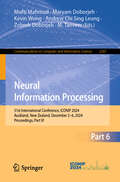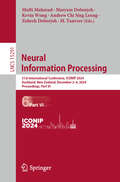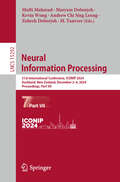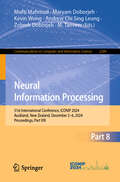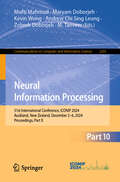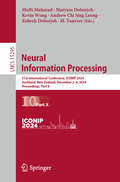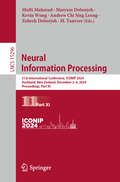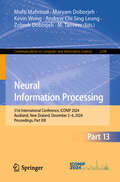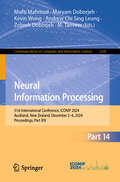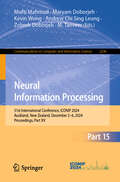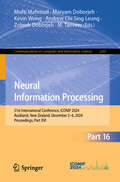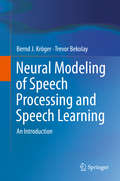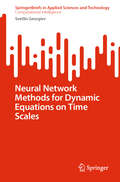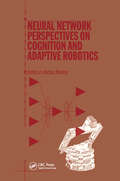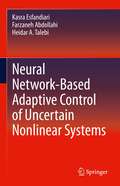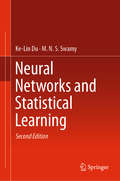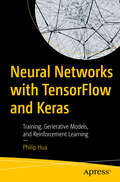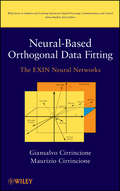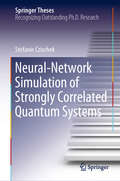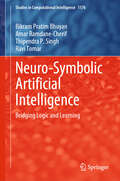- Table View
- List View
Neural Information Processing: 31st International Conference, ICONIP 2024, Auckland, New Zealand, December 2–6, 2024, Proceedings, Part VI (Communications in Computer and Information Science #2287)
by Kevin Wong M. Tanveer Mufti Mahmud Maryam Doborjeh Andrew Chi Sing Leung Zohreh DoborjehThe sixteen-volume set, CCIS 2282-2297, constitutes the refereed proceedings of the 31st International Conference on Neural Information Processing, ICONIP 2024, held in Auckland, New Zealand, in December 2024. The 472 regular papers presented in this proceedings set were carefully reviewed and selected from 1301 submissions. These papers primarily focus on the following areas: Theory and algorithms; Cognitive neurosciences; Human-centered computing; and Applications.
Neural Information Processing: 31st International Conference, ICONIP 2024, Auckland, New Zealand, December 2–6, 2024, Proceedings, Part VI (Lecture Notes in Computer Science #15291)
by Kevin Wong M. Tanveer Mufti Mahmud Maryam Doborjeh Andrew Chi Sing Leung Zohreh DoborjehThe eleven-volume set LNCS 15286-15296 constitutes the refereed proceedings of the 31st International Conference on Neural Information Processing, ICONIP 2024, held in Auckland, New Zealand, in December 2024.The 318 regular papers presented in the proceedings set were carefully reviewed and selected from 1301 submissions. They focus on four main areas, namely: theory and algorithms; cognitive neurosciences; human-centered computing; and applications.
Neural Information Processing: 31st International Conference, ICONIP 2024, Auckland, New Zealand, December 2–6, 2024, Proceedings, Part VII (Communications in Computer and Information Science #2288)
by Kevin Wong M. Tanveer Mufti Mahmud Maryam Doborjeh Andrew Chi Sing Leung Zohreh DoborjehThe sixteen-volume set, CCIS 2282-2297, constitutes the refereed proceedings of the 31st International Conference on Neural Information Processing, ICONIP 2024, held in Auckland, New Zealand, in December 2024. The 472 regular papers presented in this proceedings set were carefully reviewed and selected from 1301 submissions. These papers primarily focus on the following areas: Theory and algorithms; Cognitive neurosciences; Human-centered computing; and Applications.
Neural Information Processing: 31st International Conference, ICONIP 2024, Auckland, New Zealand, December 2–6, 2024, Proceedings, Part VII (Lecture Notes in Computer Science #15292)
by Kevin Wong M. Tanveer Mufti Mahmud Maryam Doborjeh Andrew Chi Sing Leung Zohreh DoborjehThe eleven-volume set LNCS 15286-15296 constitutes the refereed proceedings of the 31st International Conference on Neural Information Processing, ICONIP 2024, held in Auckland, New Zealand, in December 2024.The 318 regular papers presented in the proceedings set were carefully reviewed and selected from 1301 submissions. They focus on four main areas, namely: theory and algorithms; cognitive neurosciences; human-centered computing; and applications.
Neural Information Processing: 31st International Conference, ICONIP 2024, Auckland, New Zealand, December 2–6, 2024, Proceedings, Part VIII (Communications in Computer and Information Science #2289)
by Kevin Wong M. Tanveer Mufti Mahmud Maryam Doborjeh Andrew Chi Sing Leung Zohreh DoborjehThe sixteen-volume set, CCIS 2282-2297, constitutes the refereed proceedings of the 31st International Conference on Neural Information Processing, ICONIP 2024, held in Auckland, New Zealand, in December 2024. The 472 regular papers presented in this proceedings set were carefully reviewed and selected from 1301 submissions. These papers primarily focus on the following areas: Theory and algorithms; Cognitive neurosciences; Human-centered computing; and Applications.
Neural Information Processing: 31st International Conference, ICONIP 2024, Auckland, New Zealand, December 2–6, 2024, Proceedings, Part VIII (Lecture Notes in Computer Science #15293)
by Kevin Wong M. Tanveer Mufti Mahmud Maryam Doborjeh Andrew Chi Sing Leung Zohreh DoborjehThe eleven-volume set LNCS 15286-15296 constitutes the refereed proceedings of the 31st International Conference on Neural Information Processing, ICONIP 2024, held in Auckland, New Zealand, in December 2024.The 318 regular papers presented in the proceedings set were carefully reviewed and selected from 1301 submissions. They focus on four main areas, namely: theory and algorithms; cognitive neurosciences; human-centered computing; and applications.
Neural Information Processing: 31st International Conference, ICONIP 2024, Auckland, New Zealand, December 2–6, 2024, Proceedings, Part X (Communications in Computer and Information Science #2291)
by Kevin Wong M. Tanveer Mufti Mahmud Maryam Doborjeh Andrew Chi Sing Leung Zohreh DoborjehThe sixteen-volume set, CCIS 2282-2297, constitutes the refereed proceedings of the 31st International Conference on Neural Information Processing, ICONIP 2024, held in Auckland, New Zealand, in December 2024. The 472 regular papers presented in this proceedings set were carefully reviewed and selected from 1301 submissions. These papers primarily focus on the following areas: Theory and algorithms; Cognitive neurosciences; Human-centered computing; and Applications.
Neural Information Processing: 31st International Conference, ICONIP 2024, Auckland, New Zealand, December 2–6, 2024, Proceedings, Part X (Lecture Notes in Computer Science #15295)
by Kevin Wong M. Tanveer Mufti Mahmud Maryam Doborjeh Andrew Chi Sing Leung Zohreh DoborjehThe eleven-volume set LNCS 15286-15295 constitutes the refereed proceedings of the 31st International Conference on Neural Information Processing, ICONIP 2024, held in Auckland, New Zealand, in December 2024. The 318 regular papers presented in the proceedings set were carefully reviewed and selected from 1301 submissions. They focus on four main areas, namely: theory and algorithms; cognitive neurosciences; human-centered computing; and applications.
Neural Information Processing: 31st International Conference, ICONIP 2024, Auckland, New Zealand, December 2–6, 2024, Proceedings, Part XI (Communications in Computer and Information Science #2292)
by Kevin Wong M. Tanveer Mufti Mahmud Maryam Doborjeh Andrew Chi Sing Leung Zohreh DoborjehThe sixteen-volume set, CCIS 2282-2297, constitutes the refereed proceedings of the 31st International Conference on Neural Information Processing, ICONIP 2024, held in Auckland, New Zealand, in December 2024.The 472 regular papers presented in this proceedings set were carefully reviewed and selected from 1301 submissions. These papers primarily focus on the following areas: Theory and algorithms; Cognitive neurosciences; Human-centered computing; and Applications.
Neural Information Processing: 31st International Conference, ICONIP 2024, Auckland, New Zealand, December 2–6, 2024, Proceedings, Part XI (Lecture Notes in Computer Science #15296)
by Kevin Wong M. Tanveer Mufti Mahmud Maryam Doborjeh Andrew Chi Sing Leung Zohreh DoborjehThe eleven-volume set LNCS 15286-15295 constitutes the refereed proceedings of the 31st International Conference on Neural Information Processing, ICONIP 2024, held in Auckland, New Zealand, in December 2024. The 318 regular papers presented in the proceedings set were carefully reviewed and selected from 1301 submissions. They focus on four main areas, namely: theory and algorithms; cognitive neurosciences; human-centered computing; and applications.
Neural Information Processing: 31st International Conference, ICONIP 2024, Auckland, New Zealand, December 2–6, 2024, Proceedings, Part XII (Communications in Computer and Information Science #2293)
by Kevin Wong M. Tanveer Mufti Mahmud Maryam Doborjeh Andrew Chi Sing Leung Zohreh DoborjehThe sixteen-volume set, CCIS 2282-2297, constitutes the refereed proceedings of the 31st International Conference on Neural Information Processing, ICONIP 2024, held in Auckland, New Zealand, in December 2024.The 472 regular papers presented in this proceedings set were carefully reviewed and selected from 1301 submissions. These papers primarily focus on the following areas: Theory and algorithms; Cognitive neurosciences; Human-centered computing; and Applications.
Neural Information Processing: 31st International Conference, ICONIP 2024, Auckland, New Zealand, December 2–6, 2024, Proceedings, Part XIII (Communications in Computer and Information Science #2294)
by Kevin Wong M. Tanveer Mufti Mahmud Maryam Doborjeh Andrew Chi Sing Leung Zohreh DoborjehThe sixteen-volume set, CCIS 2282-2297, constitutes the refereed proceedings of the 31st International Conference on Neural Information Processing, ICONIP 2024, held in Auckland, New Zealand, in December 2024.The 472 regular papers presented in this proceedings set were carefully reviewed and selected from 1301 submissions. These papers primarily focus on the following areas: Theory and algorithms; Cognitive neurosciences; Human-centered computing; and Applications.
Neural Information Processing: 31st International Conference, ICONIP 2024, Auckland, New Zealand, December 2–6, 2024, Proceedings, Part XIV (Communications in Computer and Information Science #2295)
by Kevin Wong M. Tanveer Mufti Mahmud Maryam Doborjeh Andrew Chi Sing Leung Zohreh DoborjehThe sixteen-volume set, CCIS 2282-2297, constitutes the refereed proceedings of the 31st International Conference on Neural Information Processing, ICONIP 2024, held in Auckland, New Zealand, in December 2024.The 472 regular papers presented in this proceedings set were carefully reviewed and selected from 1301 submissions. These papers primarily focus on the following areas: Theory and algorithms; Cognitive neurosciences; Human-centered computing; and Applications.
Neural Information Processing: 31st International Conference, ICONIP 2024, Auckland, New Zealand, December 2–6, 2024, Proceedings, Part XV (Communications in Computer and Information Science #2296)
by Kevin Wong M. Tanveer Mufti Mahmud Maryam Doborjeh Andrew Chi Sing Leung Zohreh DoborjehThe sixteen-volume set, CCIS 2282-2297, constitutes the refereed proceedings of the 31st International Conference on Neural Information Processing, ICONIP 2024, held in Auckland, New Zealand, in December 2024. The 472 regular papers presented in this proceedings set were carefully reviewed and selected from 1301 submissions. These papers primarily focus on the following areas: Theory and algorithms; Cognitive neurosciences; Human-centered computing; and Applications.
Neural Information Processing: 31st International Conference, ICONIP 2024, Auckland, New Zealand, December 2–6, 2024, Proceedings, Part XVI (Communications in Computer and Information Science #2297)
by Kevin Wong M. Tanveer Mufti Mahmud Maryam Doborjeh Andrew Chi Sing Leung Zohreh DoborjehThe sixteen-volume set, CCIS 2282-2297, constitutes the refereed proceedings of the 31st International Conference on Neural Information Processing, ICONIP 2024, held in Auckland, New Zealand, in December 2024. The 472 regular papers presented in this proceedings set were carefully reviewed and selected from 1301 submissions. These papers primarily focus on the following areas: Theory and algorithms; Cognitive neurosciences; Human-centered computing; and Applications.
Neural Modeling of Speech Processing and Speech Learning: An Introduction
by Bernd J. Kröger Trevor BekolayThis book explores the processes of spoken language production and perception from a neurobiological perspective. After presenting the basics of speech processing and speech acquisition, a neurobiologically-inspired and computer-implemented neural model is described, which simulates the neural processes of speech processing and speech acquisition. This book is an introduction to the field and aimed at students and scientists in neuroscience, computer science, medicine, psychology and linguistics.
Neural Network Analysis, Architectures and Applications
by Antony BrowneNeural Network Analysis, Architectures and Applications discusses the main areas of neural networks, with each authoritative chapter covering the latest information from different perspectives. Divided into three parts, the book first lays the groundwork for understanding and simplifying networks. It then describes novel architectures and algorithms, including pulse-stream techniques, cellular neural networks, and multiversion neural computing. The book concludes by examining various neural network applications, such as neuron-fuzzy control systems and image compression. This final part of the book also provides a case study involving oil spill detection. This book is invaluable for students and practitioners who have a basic understanding of neural computing yet want to broaden and deepen their knowledge of the field.
Neural Network Methods for Dynamic Equations on Time Scales (SpringerBriefs in Applied Sciences and Technology)
by Svetlin GeorgievThis book aims to handle dynamic equations on time scales using artificial neural network (ANN). Basic facts and methods for ANN modeling are considered. The multilayer artificial neural network (ANN) model is introduced for solving of dynamic equations on arbitrary time scales. A multilayer ANN model with one input layer containing a single node, a hidden layer with m nodes, and one output node are investigated. The feed-forward neural network model and unsupervised error back-propagation algorithm are developed. Modification of network parameters is done without the use of any optimization technique. The regression-based neural network (RBNN) model is introduced for solving dynamic equations on arbitrary time scales. The RBNN trial solution of dynamic equations is obtained by using the RBNN model for single input and single output system. A variety of initial and boundary value problems are solved. The Chebyshev neural network (ChNN) model and Levendre neural network model are developed. The ChNN trial solution of dynamic equations is obtained by using the ChNN model for single input and single output system. This book is addressed to a wide audience of specialists such as mathematicians, physicists, engineers, and biologists. It can be used as a textbook at the graduate level and as a reference book for several disciplines.
Neural Network Perspectives on Cognition and Adaptive Robotics
by A. BrowneFeaturing an international team of authors, Neural Network Perspectives on Cognition and Adaptive Robotics presents several approaches to the modeling of human cognition and language using neural computing techniques. It also describes how adaptive robotic systems can be produced using neural network architectures. Covering a wide range of mainstream area and trends, each chapter provides the latest information from a different perspective.
Neural Network-Based Adaptive Control of Uncertain Nonlinear Systems
by Heidar A. Talebi Farzaneh Abdollahi Kasra EsfandiariThe focus of this book is the application of artificial neural networks in uncertain dynamical systems. It explains how to use neural networks in concert with adaptive techniques for system identification, state estimation, and control problems. The authors begin with a brief historical overview of adaptive control, followed by a review of mathematical preliminaries. In the subsequent chapters, they present several neural network-based control schemes. Each chapter starts with a concise introduction to the problem under study, and a neural network-based control strategy is designed for the simplest case scenario. After these designs are discussed, different practical limitations (i.e., saturation constraints and unavailability of all system states) are gradually added, and other control schemes are developed based on the primary scenario. Through these exercises, the authors present structures that not only provide mathematical tools for navigating control problems, but also supply solutions that are pertinent to real-life systems.
Neural Networks and Statistical Learning
by Ke-Lin Du M. N. SwamyThis book provides a broad yet detailed introduction to neural networks and machine learning in a statistical framework. A single, comprehensive resource for study and further research, it explores the major popular neural network models and statistical learning approaches with examples and exercises and allows readers to gain a practical working understanding of the content. This updated new edition presents recently published results and includes six new chapters that correspond to the recent advances in computational learning theory, sparse coding, deep learning, big data and cloud computing.Each chapter features state-of-the-art descriptions and significant research findings. The topics covered include:• multilayer perceptron;• the Hopfield network;• associative memory models;• clustering models and algorithms;• t he radial basis function network;• recurrent neural networks;• nonnegative matrix factorization;• independent component analysis;•probabilistic and Bayesian networks; and• fuzzy sets and logic.Focusing on the prominent accomplishments and their practical aspects, this book provides academic and technical staff, as well as graduate students and researchers with a solid foundation and comprehensive reference on the fields of neural networks, pattern recognition, signal processing, and machine learning.
Neural Networks with TensorFlow and Keras: Training, Generative Models, and Reinforcement Learning
by Philip HuaExplore the capabilities of machine learning and neural networks. This comprehensive guidebook is tailored for professional programmers seeking to deepen their understanding of neural networks, machine learning techniques, and large language models (LLMs). The book explores the core of machine learning techniques, covering essential topics such as data pre-processing, model selection, and customization. It provides a robust foundation in neural network fundamentals, supplemented by practical case studies and projects. You will explore various network topologies, including Deep Neural Networks (DNN), Recurrent Neural Networks (RNN), Long Short-Term Memory (LSTM) networks, Variational Autoencoders (VAE), Generative Adversarial Networks (GAN), and Large Language Models (LLMs). Each concept is explained with clear, step-by-step instructions and accompanied by Python code examples using the latest versions of TensorFlow and Keras, ensuring a hands-on learning experience. By the end of this book, you will gain practical skills to apply these techniques to solving problems. Whether you are looking to advance your career or enhance your programming capabilities, this book provides the tools and knowledge needed to excel in the rapidly evolving field of machine learning and neural networks. What You Will Learn Grasp the fundamentals of various neural network topologies, including DNN, RNN, LSTM, VAE, GAN, and LLMs Implement neural networks using the latest versions of TensorFlow and Keras, with detailed Python code examples Know the techniques for data pre-processing, model selection, and customization to optimize machine learning models Apply machine learning and neural network techniques in various professional scenarios Who This Book Is For Data scientists, machine learning enthusiasts, and software developers who wish to deepen their understanding of neural networks and machine learning techniques
Neural-Based Orthogonal Data Fitting
by Giansalvo Cirrincione Maurizio CirrincioneThe presentation of a novel theory in orthogonal regressionThe literature about neural-based algorithms is often dedicated to principal component analysis (PCA) and considers minor component analysis (MCA) a mere consequence. Breaking the mold, Neural-Based Orthogonal Data Fitting is the first book to start with the MCA problem and arrive at important conclusions about the PCA problem.The book proposes several neural networks, all endowed with a complete theory that not only explains their behavior, but also compares them with the existing neural and traditional algorithms. EXIN neurons, which are of the authors' invention, are introduced, explained, and analyzed. Further, it studies the algorithms as a differential geometry problem, a dynamic problem, a stochastic problem, and a numerical problem. It demonstrates the novel aspects of its main theory, including its applications in computer vision and linear system identification. The book shows both the derivation of the TLS EXIN from the MCA EXIN and the original derivation, as well as:Shows TLS problems and gives a sketch of their history and applicationsPresents MCA EXIN and compares it with the other existing approachesIntroduces the TLS EXIN neuron and the SCG and BFGS acceleration techniques and compares them with TLS GAOOutlines the GeTLS EXIN theory for generalizing and unifying the regression problemsEstablishes the GeMCA theory, starting with the identification of GeTLS EXIN as a generalization eigenvalue problemIn dealing with mathematical and numerical aspects of EXIN neurons, the book is mainly theoretical. All the algorithms, however, have been used in analyzing real-time problems and show accurate solutions. Neural-Based Orthogonal Data Fitting is useful for statisticians, applied mathematics experts, and engineers.
Neural-Network Simulation of Strongly Correlated Quantum Systems (Springer Theses)
by Stefanie CzischekQuantum systems with many degrees of freedom are inherently difficult to describe and simulate quantitatively. The space of possible states is, in general, exponentially large in the number of degrees of freedom such as the number of particles it contains. Standard digital high-performance computing is generally too weak to capture all the necessary details, such that alternative quantum simulation devices have been proposed as a solution. Artificial neural networks, with their high non-local connectivity between the neuron degrees of freedom, may soon gain importance in simulating static and dynamical behavior of quantum systems. Particularly promising candidates are neuromorphic realizations based on analog electronic circuits which are being developed to capture, e.g., the functioning of biologically relevant networks. In turn, such neuromorphic systems may be used to measure and control real quantum many-body systems online. This thesis lays an important foundation for the realization of quantum simulations by means of neuromorphic hardware, for using quantum physics as an input to classical neural nets and, in turn, for using network results to be fed back to quantum systems. The necessary foundations on both sides, quantum physics and artificial neural networks, are described, providing a valuable reference for researchers from these different communities who need to understand the foundations of both.
Neuro-Symbolic Artificial Intelligence: Bridging Logic and Learning (Studies in Computational Intelligence #1176)
by Ravi Tomar Amar Ramdane-Cherif Thipendra P. Singh Bikram Pratim BhuyanThis book highlights and attempts to fill a crucial gap in the existing literature by providing a comprehensive exploration of the emerging field of neuro-symbolic AI. It introduces the concept of neuro-symbolic AI, highlighting its fusion of symbolic reasoning and machine learning. The book covers symbolic AI and knowledge representation, neural networks and deep learning, neuro-symbolic integration approaches, reasoning and inference techniques, applications in healthcare and robotics, as well as challenges and future directions. By combining the power of symbolic logic and knowledge representation with the flexibility of neural networks, neuro-symbolic AI offers the potential for more interpretable and trustworthy AI systems. This book is a valuable resource for researchers, practitioners, and students interested in understanding and applying neuro-symbolic AI.
